Dal Fry is a delicious and popular Indian lentil recipe that is made with tuvar dal (pigeon pea lentils), onions, tomatoes and spices. Relish this flavorful, mildly-spiced, creamy lentil dish with roti, naan or your favorite steamed rice. I share 3 ways of making dal fry recipe – stovetop pressure cooker method with stepwise photos, while the pan and Instant pot method with detailed instructions.
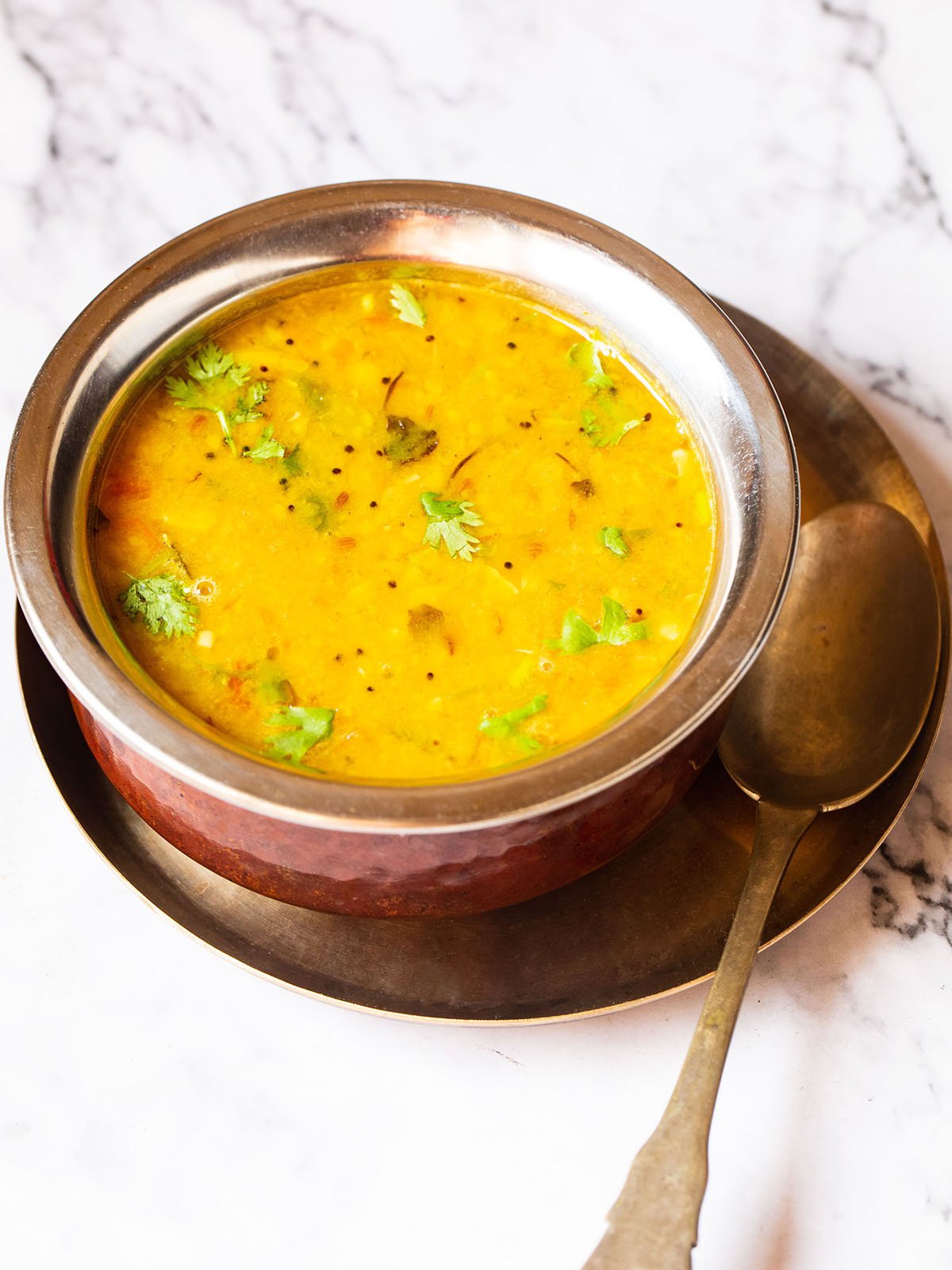
Table of Contents
What is Dal Fry
In Hindi language, ‘dal’ or ‘dahl’ is the generic term for lentils as well as the recipes made from lentils. Dal or lentils are a staple in Indian cuisine and make for an excellent plant-based source of protein.
Dal Fry is a dish that is made in various ways in many Indian homes with tuvar dal or pigeon pea lentils.
If you are new to Indian cuisine, you may think that the words ‘dal fry’ indicate that some ingredients are being fried or the lentils are fried. Let me assure you that we don’t fry anything in a dal fry.
Here is how we make it. First, the lentils are cooked until soft and mushy. Note that we do not cook al dente lentils.
The soft-cooked lentils or dal is then mixed with a sautéed mixture of spices, onions, tomatoes and herbs. Then simmered for a few minutes.
In the Indian terminology, we often use the word ‘fry’ for ‘sautéed’ and hence the term dal fry. Though technically speaking nothing is deep fried or shallow fried.
About This Restaurant Style Dal Recipe
My dal fry recipe offers you a lot of restaurant-like flavors and you will love it to relish with some phulka or rice or paratha or even with tandoori roti.
It is usually prepared with arhar dal, also known as toor, toovar (yellow lentils) or pigeon pea lentils.
I like to use an equal mix of masoor dal (pink or orange lentils) and tuvar dal (pigeon pea lentils), but this recipe is easily adaptable with any lentils you have in your pantry. But I highly recommend to use lentils which are in their shelf life.
The apt and fitting inclusions of the various ingredients that go into making of this dal fry recipe give it a restaurant style flavor.
To add more, you can smoke the dal fry with charcoal. I have mentioned in detail about this smoking technique in my Dal Tadka Recipe which you can have a look at.
I usually cook the lentils in a stove-top pressure cooker, but you can cook them in a pan or in an Instant Pot if you do not have a pressure cooker on hand. Details are given below.
Ingredients You Need
I use ingredients that are easily available in an Indian kitchen. If you do not have these ingredients, then buy them online or from an Asian or Indian grocery store.
- Veggies: You will need an onion and tomato, both finely chopped for this dal fry recipe.
- Green Chilies: Not as hot as jalapeños but just the right level of spice for the dish.
- Curry Leaves: The subtle flavor of curry leaves are essential in this recipe. But if you don’t have it, then might well as skip it – though some flavor profile will be amiss.
- Asafoetida Powder (hing): If using a strong asafoetida, then just one pinch is enough. I would definitely recommend adding a small amount at a time and seasoning to taste. And if you do not have asafoetida, then simply skip it.
- Coriander leaves (cilantro): This simple herb brings a much needed hint of freshness to the dal fry.
- Kasuri Methi (dry fenugreek leaves): Brings restaurant style flavors to the dal and gives a nutty aroma. Skip if you do not have it.
- Additional Seasonings: You will also need several Indian pantry staples, including ginger, black mustard seeds, cumin seeds, turmeric powder, red chili powder, Garam Masala powder, oil, lemon juice, and salt.
How to Make Dal Fry Recipe
Cook Dal
1. Rinse your lentils in water for 3 to 4 times. I would recommend using ½ cup tuvar dal (arhar dal or pigeon pea lentils) or ¼ cup each of tuvar dal and masoor dal (pink or orange lentils).

2. After rinsing, pour the lentils into a 2-liter pressure cooker and toss in a pinch of turmeric powder and 1.5 cups of water.
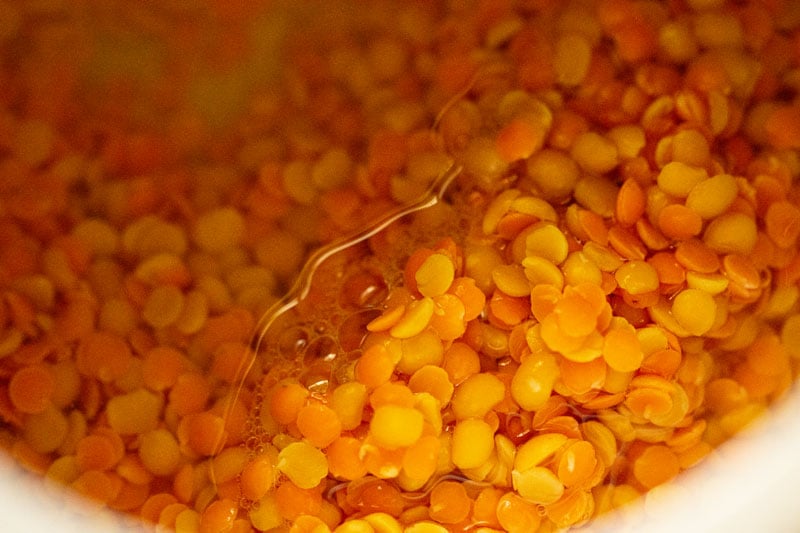
3. Pressure cook the lentils for 9 to 10 minutes on medium heat, or until they are thoroughly cooked and completely soft. Once lentils are cooked, mash them with a spoon or wired whisk, then set aside.
Tip: You can see the consistency of the cooked lentils in the photo below. It is important to note that there should be no separate grains visible.
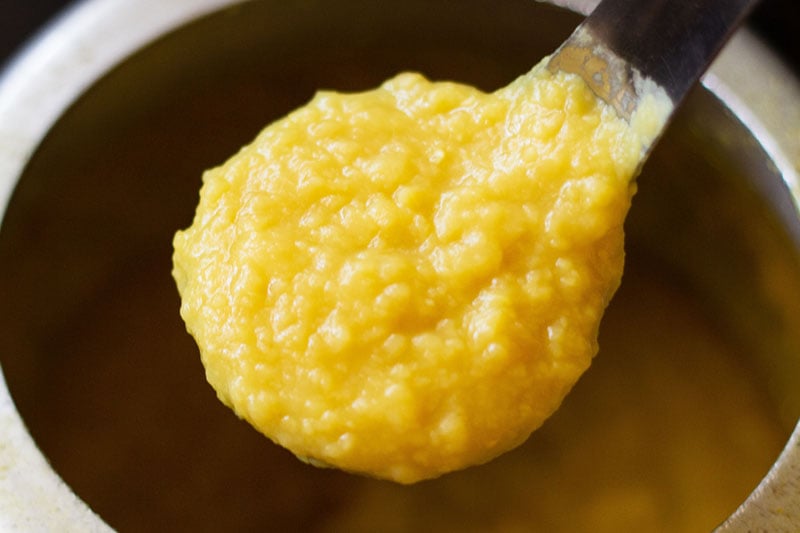
Sauté Onions, Tomatoes, Spices
4. Heat 2 to 3 tablespoons of oil, ghee or unsalted butter in a pan or skillet. Once hot, add ½ or ¾ teaspoon of black mustard seeds.

5. When you hear the mustard seeds start crackling, add 1 teaspoon of cumin seeds and fry them with the mustard seeds for several seconds or until they change color. You should hear the same crackle for the cumin seeds!
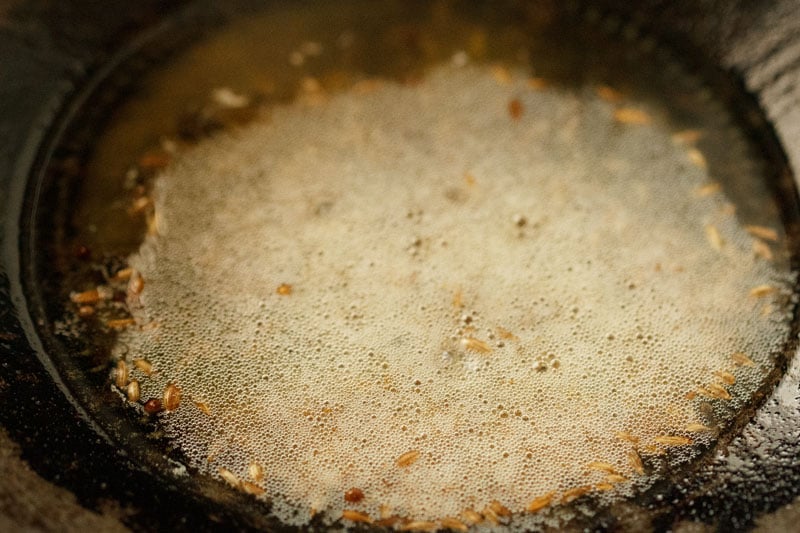
6. With the mustard and cumin seeds still in the pan, add ⅓ cup of chopped onions.

7. Sauté the seeds and onion mixture until the onions become translucent or lightly browned.

8. When the onions have lightly browned, add in 1 to 1.5 teaspoons ginger-garlic paste and stir to combine. Sauté the mixture for a few seconds or until the raw aroma of the ginger-garlic goes away on a low heat.
Tip: Make your own paste by combining 1 inch ginger with 3 to 4 medium-sized garlic cloves, crushed to a paste in a mortar-pestle.
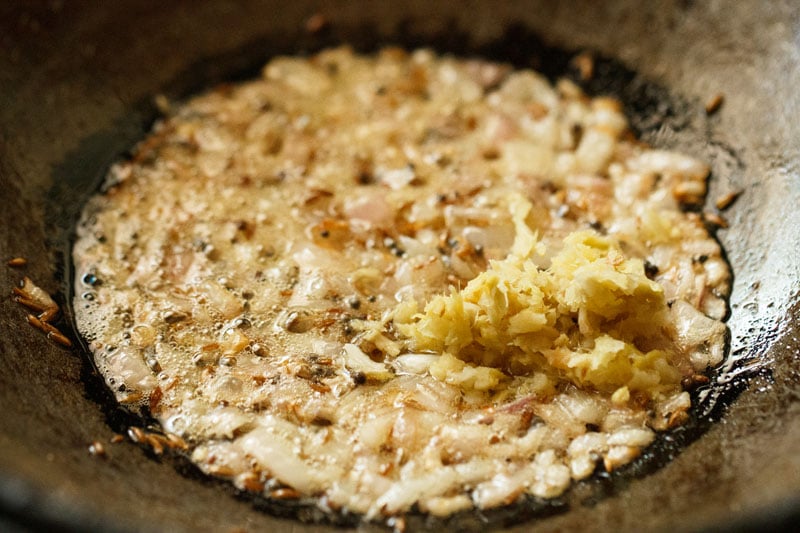
9. Finally, add in 10 to 12 curry leaves, 2 to 3 dry red chilies, and 1 to 2 green chilies. Stir to combine with the ginger-garlic paste mixture.
TIP: You can skip the curry leaves if you don’t have them! I always like to add curry leaves, as they add such a nice flavor to the dish.

10. Mix well on a low heat, stirring to combine the flavors.
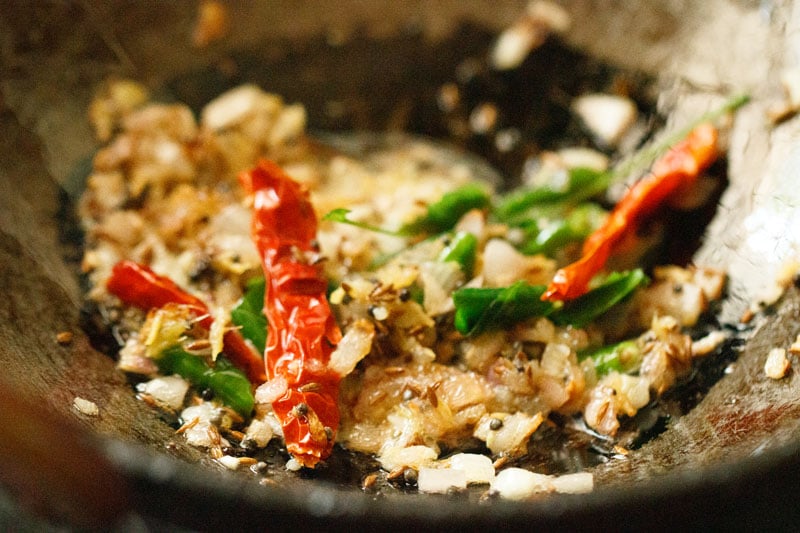
11. Add all the spice powders and mix again!
- ½ teaspoon turmeric powder (ground turmeric)
- ½ teaspoon red chili powder or cayenne or smoked paprika (For a light smoky flavor)
- 1 to 2 pinches of asafoetida, or hing (Skip if you do not have it.)

12. After mixing thoroughly, add about ⅓ to ½ cup of finely chopped tomatoes.

13. Stir together one more time and continue to sauté until the tomatoes become soft and pulpy.
The oil should also start to leave the masala mixture, which is an indication that the onion-tomato base mixture is fully cooked.
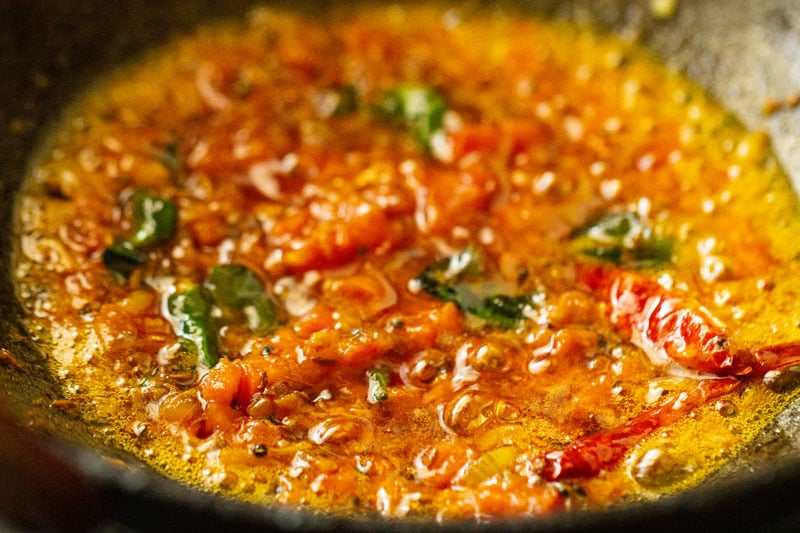
Make Dal Fry
14. Add your mashed lentils to sautéed onion-tomato masala mixture in the pan or skillet.
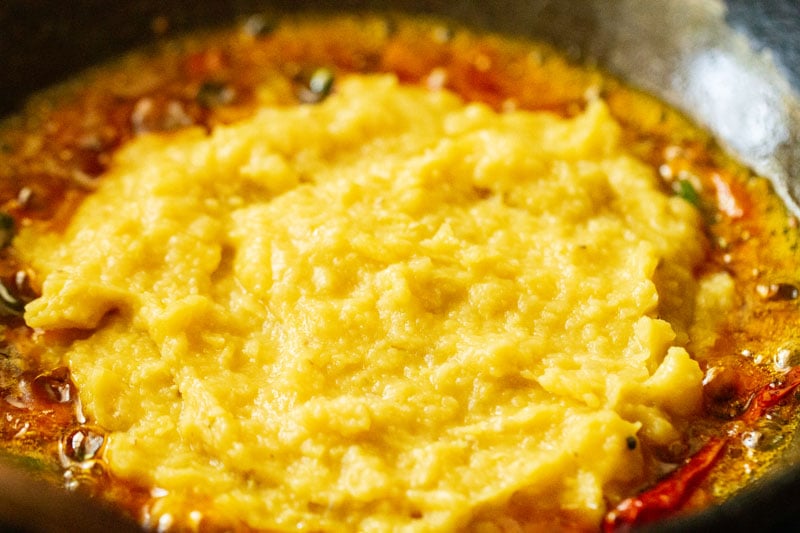
15. Combine and mix everything evenly with the rest of the masala mixture.

16. Pour 1 to 1.5 cups of water. You can adjust the consistency of dal fry by adding more or less water as per your taste preferences.

17. Mix and stir thoroughly to get a smooth and even consistency.

18. Season with salt as per taste. Stir and mix again.
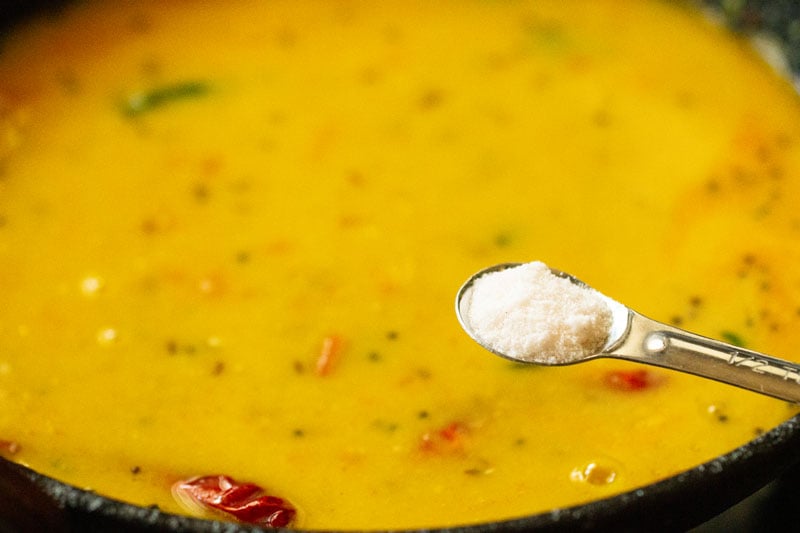
Simmer Dal Further
19. Simmer for 5 to 6 minutes on low to medium heat. Stir occasionally, so that the lentils do not stick to the bottom of the pan.

20. Add 1 teaspoon of crushed kasoori methi (dried fenugreek leaves) and sprinkle ¼ to ½ teaspoon of garam masala powder.
Tip 1: You can substitute kasoori methi with a pinch of fenugreek seeds powder. If you don’t have either, then just skip this step.
Tip 2: If you are using homemade or a strong garam masala, then add ¼ teaspoon.

21. Stir and simmer for 1 minute.

22. Switch off the heat and add 2 tablespoons of chopped coriander leaves. You can also add ½ to 1 teaspoon lemon juice at this step for a little added freshness and tang.
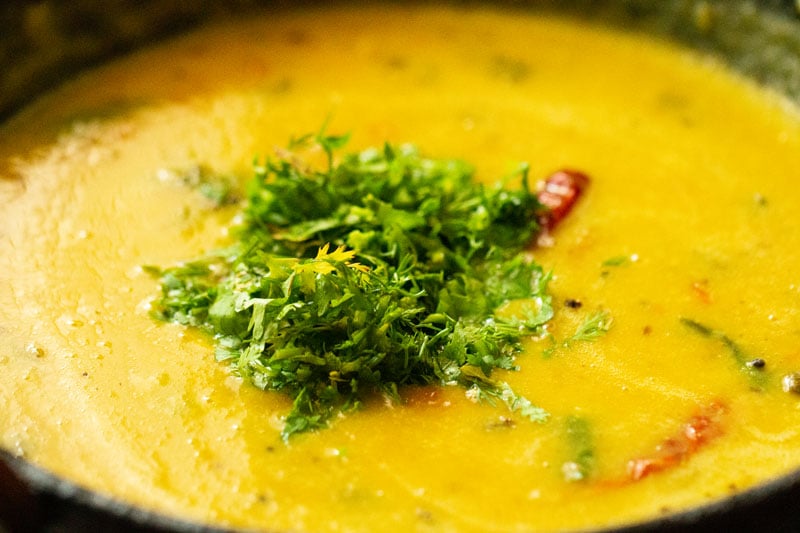
23. Stir just one last time.
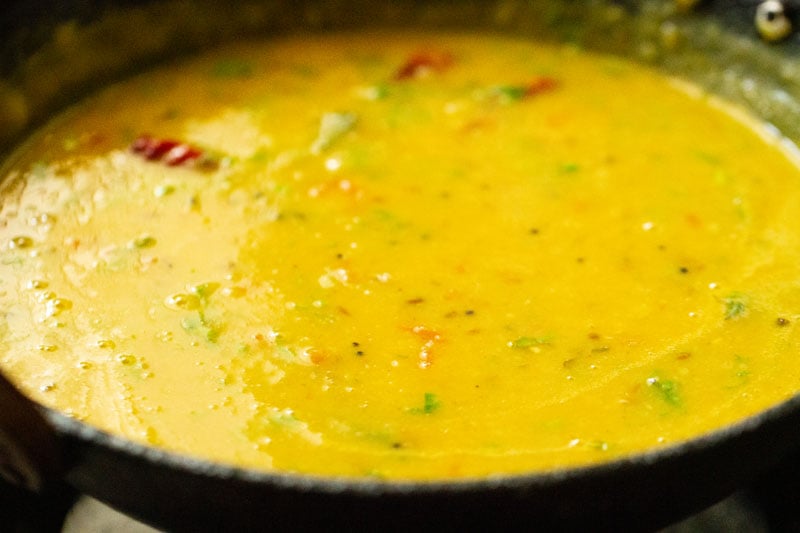
Serve dal fry hot or warm with paratha, roti, jeera rice or plain steamed basmati rice accompanied with onion-tomato raita, papad, lime/lemon slices or mango pickle or onion salad or kachumber.
You can also garnish with some more coriander leaves before serving.
For the best taste and flavor consume it as soon as it is prepared. On reheating you will need to add a bit of water.

What to Serve with Dal Fry
- Roti is a round flatbread popular in India, and a staple bread that is served with lentils or curries. Soft roti tastes great with piping hot dal.
- Naan, a leavened flatbread made in some countries in Asia, is not as much of an Indian household staple as roti, but it is still a deliciously soft and slightly chewy side option.
- Steamed rice always goes great with dal fry recipes, and you can make it in the pressure cooker to save cook time.
- Jeera Rice, which is a simple yet delish cumin flavored rice is a fabulous option to serve with dal fry.
Method 2 – Instant Pot Dal Fry
In the Instant Pot, you simply need to cook everything together. Though the taste of dal fry made in the Instant Pot is different from the one made on the stove-top. Follow the steps below to make instant pot dal fry.
Sautéing in the IP
- Frying spices: Press the sauté button of your IP. Let the display show hot. Add ghee or oil in the steel insert. Add the mustard seeds to the hot oil or melted ghee and let them crackle first. Then add the cumin seeds and let them splutter.
- Sautéing aromatics: Next add in the chopped onions and sauté until they soften. Add ginger-garlic paste and sauté for a few seconds. Stir in the curry leaves, dry red chillies and green red chillies. Again sauté for a few seconds.
- Cooking tomatoes and spices: Add chopped tomatoes and sauté them until they soften. Mix in the turmeric powder, red chilli powder and asafoetida.
Pressure Cooking in IP
- Adding lentils: Add the rinsed lentils and 1.5 cups of water. Deglaze removing any ingredient bits stuck to the bottom of the steel insert. Season with salt as needed.
- Pressure cooking: Secure the lid of your IP and position the steam release handle to sealing. Press the pressure cook button setting the time to 15 minutes on high pressure. It may take 10 to 15 minutes for the lentils to cook depending on their age and quality. For a dal fry, the lentils have to be softened nicely.
- Waiting: When you hear the beep after the pressure cooking is done wait for 10 minutes and then do a quick pressure release.
Simmering Further
- Dal consistency: Lightly mash the cooked dal. If you find that the dal has become thick, add some hot water to thin and lighten it up. If the dal is thin for your liking, press the sauté button and simmer for a few minutes.
- Final touches: Lastly add the kasuri methi, garam masala powder and coriander leaves. Mix and switch off your IP. Serve hot or warm.
Method 3 – Cooking Lentils in a Pan
- First, rinse and soak the lentils for thirty minutes to an hour. Soaking helps the lentils to cook faster. Later drain all the water with a sieve or colander.
- In a pan take the soaked lentils and 2 to 2.5 cups water. Add 1 teaspoon of oil. Cover and cook the lentils on medium-low to medium heat. If the water froths too much, then remove the lid and cook. It may take 30 to 45 minutes for the lentils to soften and become mushy. Keep a check and if needed, add some more water.
- Then follow the recipe instructions as detailed in the step-by-step guide above to make dal fry with your cooked lentils.
Dal Tadka vs Dal Fry
A popular lentil dish often served in Indian restaurants, Dal Fry should not be confused with the classic dal tadka.
Both these lentil recipes are made with different cooking techniques. While the ingredients are more or less the same, the unique cooking methods implied, makes a difference to the final flavors and taste.
- In a dal tadka, the tuvar dal is cooked with aromatics like onions, garlic or ginger, turmeric and tomatoes. After being lightly mashed, a tadka or tempering mixture (fried in ghee or oil) of spices, herbs and seasonings are added to the dal – then mixed and served.
- For a dal fry, the tuvar dal is simply cooked plain or with the addition of turmeric or asafoetida – which is then mixed with a sautéed onion-tomato base and further simmered.
Both of these recipes are famous in the Dhabas (highways and roadside eateries) in India, though the Dhaba Dal served in the Dhabas has a different taste than this recipe.
Expert Tips for Best Dal Fry
- Consistency: You can alter the consistency of dal by adding less or more water. If you prefer a thinner consistency, then increase the amount of water a bit and not too much. If dal becomes thin or runny, the flavors will get diluted and it won’t taste good. Keep checking and if needed, add more water.
While serving with rice we keep the consistency to medium. When serving with roti or phulka we keep the consistency slightly thick. On cooling the dal will thicken a bit. - Fats: Dal fry always taste better with ghee. But you can make it with oil or butter. Use sunflower oil, safflower oil, peanut oil, mustard oil or coconut oil. Note that mustard oil and coconut oil will give their taste and flavor in the lentils – so add according to your preferences.
- Smoky flavors: For more restaurant style flavors, you can smoke the dal using the dhungar method, I have described in my Dal Makhani recipe. Alternatively, use smoked paprika in place of red chilli powder or cayenne to get a faint smoky flavor.
FAQs
You can make dal fry recipe with moong dal (yellow mung lentils), chana dal (bengal gram) and masoor dal (orange lentils), or you can opt for a combination of these.
Just ensure that the lentils are in their shelf period and are not aged or old. If possible try to use unpolished lentils.
For a less spicy dal fry, add less chili powder and green chilies. You can always adjust the spices according to your taste.
To make a gluten-free recipe, simply skip the asafoetida (hing) in the recipe or use a gluten-free asafoetida.
More Indian Lentils Recipes!
Dal (Lentils) & Legumes
Dal (Lentils) & Legumes
Dal (Lentils) & Legumes
Dal (Lentils) & Legumes
Please be sure to rate the recipe in the recipe card or leave a comment below if you have made it. For more vegetarian inspirations, Sign Up for my emails or follow me on Instagram, Youtube, Facebook, Pinterest or Twitter.
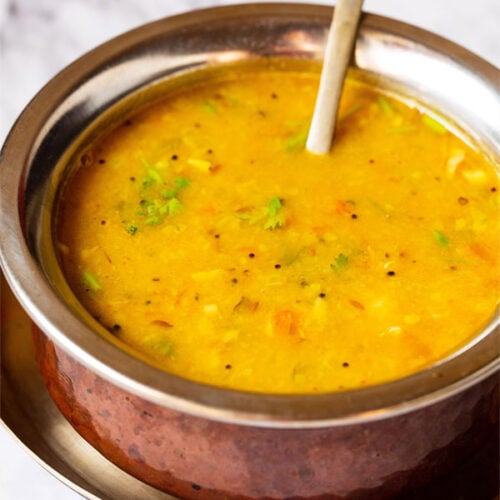
Dal Fry Recipe
Ingredients
For pressure cooking lentils
- ½ cup pigeon pea lentils – hulled and split, (tuvar dal, arhar dal, toor dal) or ¼ cup each of masoor dal and tuvar dal
- 1.5 cups water – for stovetop pressure cooking
- 1 pinch turmeric powder (ground turmeric)
Other ingredients
- 2 to 3 tablespoons oil (neutral flavored) or unsalted butter or ghee (clarified butter)
- ½ to ¾ teaspoon mustard seeds (black)
- 1 teaspoon cumin seeds
- ⅓ cup finely chopped onions or 1 medium-sized
- 1 to 1.5 teaspoons Ginger Garlic Paste or 1 inch ginger & 3 to 4 medium garlic cloves crushed in a mortar-pestle
- 2 green chilies – slit or chopped
- 2 to 3 dry red chilies – kept whole or halved and deseeded, optional
- 10 to 12 curry leaves
- 1 to 2 pinches asafoetida powder (hing) – for a strong asafoetida, just one pinch is enough
- ½ teaspoon turmeric powder (ground turmeric)
- ½ teaspoon red chili powder or cayenne pepper or smoked paprika
- ⅓ to ½ cup finely chopped tomatoes or 1 medium-sized
- 1 to 1.5 cups water or add as required
- salt as required
- 1 teaspoon dry fenugreek leaves (kasuri methi)
- ¼ to ½ teaspoon Garam Masala
- ½ to 1 teaspoon lemon juice – optional
- 2 to 3 tablespoon chopped coriander leaves (cilantro) for garnish
Instructions
Cooking lentils
- Take tuvar dal (arhar dal or pigeon pea lentils) or half-half of tuvar dal and masoor dal (pink or orange lentils) in a colander or sieve.
- Rinse the lentils in water three to four times. Drain all the water.
- Then add the lentils in a 2- litre pressure cooker. Add a pinch of turmeric powder (haldi) and 1.5 cups water.
- Pressure cook the lentils for 9 to 10 minutes on a medium heat until they are softened thoroughly.
- Once the lentils are cooked, then mash them lightly with a wired whisk or with a spoon and set aside.
Sautéing onions, tomatoes, spices
- In another pan heat oil or ghee or unsalted butter. Add the mustard seeds and let them splutter.
- When you hear the spluttering sound of the mustard seeds, add the cumin and fry them.
- Add the onions and sauté stirring often until they become translucent or light brown.
- Now add the ginger-garlic paste and sauté for some seconds or until their raw aroma disappears.
- Add the green chilies, red chilies, curry leaves and mix well.
- Add all the spice powders – turmeric powder, red chili powder, asafoetida powder. Stir and mix again.
- Add the tomatoes and cook until they soften and you see oil releasing from the sides of the masala.
Making dal fry (stovetop)
- Now add the cooked and mashed lentils. Mix thoroughly. Add water, salt and mix again.
- Simmer for 4 to 5 minutes more or till you get a smooth and slightly thick consistency, stirring at intervals.
- Dal fry is not thin and is usually has a medium to thick consistency. So you can adjust the amount of water you want.
- Keep the dal to a medium consistency if you prefer. Making it very thin will dilute the flavors.
- Lastly crush the kasuri methi in the palms of your hands and add. Then add garam masala powder. Simmer for a minute. Switch off the heat and add chopped coriander leaves. Add lemon juice if you want, at this stage and stir well.
- You can garnish dal fry with some more coriander leaves while serving.
- While serving top it with some ghee or butter if required.
- Serve dal fry hot with steamed basmati rice, biryani rice, jeera rice or saffron pulao. It also goes well with roti or naan.
Instant Pot Dal Fry
- Press the sauté button of your IP. Let the display show hot. Add ghee or oil in the steel insert.
- Add the mustard seeds to the hot oil or melted ghee and let them crackle first. When you heat them crackling, add the cumin seeds and let them splutter.
- Then add the chopped onions and sauté stirring often until they soften.
- Add ginger-garlic paste and sauté for a few seconds.
- Stir in the curry leaves, dry red chillies and green red chillies. Again sauté for a few seconds.
- Add chopped tomatoes and sauté them until they soften.
- Next add the turmeric powder, red chilli powder and asafoetida and mix well.
- Add the rinsed lentils and 1.5 cups of water. Deglaze removing any ingredient bits stuck to the bottom of the steel insert. Season with salt as needed.
- Secure the lid of your IP and position the steam release handle to sealing. Press the pressure cook/manual button, setting the time to 15 minutes on high pressure. It may take 10 to 15 minutes for the lentils to cook depending on their age and quality. For a dal fry, the lentils have to be softened nicely.
- When you hear the beep after the pressure cooking is done wait for 10 minutes and then do a quick pressure release.
- Lightly mash the cooked lentils. If you find that the dal has become thick, add some hot water to thin and lighten it up. If the dal is thin for your liking, press the sauté button and simmer for a few minutes.
- Lastly add the kasuri methi, garam masala powder and coriander leaves. Mix and switch off your IP. Serve dal fry hot or warm.
Video
Notes
- Lentils: You can also make dal fry with moong dal (yellow mung lentils), chana dal (bengal gram) and masoor dal (orange lentils) or you can opt for a combination of these three lentils.
- Cooking lentils in a pot or pan: Rinse and soak the lentils in water for thirty minutes to an hour. Later draining all the water using a sieve or colander, add the lentils in a wide enough pot or pan. Pour 2 to 2.5 cups of water with 1 teaspoon oil and cook on medium heat with or without lid until the lentils are softened. Keep checking and if needed, add more water.
- Consistency: For a thicker dal, add less water. For a slightly thinner consistency, add a bit more water. But do not make the it very thin as it will dilute the flavors.
- Spicing: For a less spiced dal, add less chilli powder and green chillies. For a spicy tasting dal fry, increase the amount of red chilli powder and green chillies.
- Fats: Dal fry always taste better with ghee. But you can make it with oil or butter. Use sunflower oil, safflower oil, peanut oil, mustard oil or coconut oil. Note that mustard oil and coconut oil will give their taste and flavor in the lentils – so add according to your preferences.
- Gluten-free version: To make a gluten-free recipe, simply skip the asafoetida (hing) in the recipe or use a gluten-free asafoetida.
- Smoky flavors: For more restaurant style flavors in your dal fry, you can smoke the dal using the dhungar method, I have described in my Dal Makhani recipe. Alternatively, use smoked paprika in place of red chilli powder or cayenne to get a faint smoky flavor.
Nutrition Info (Approximate Values)
This Dal Fry recipe from the blog archives was first published in August 2009. It has been updated and republished on June 2022.


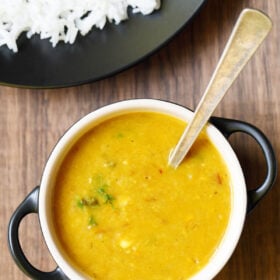









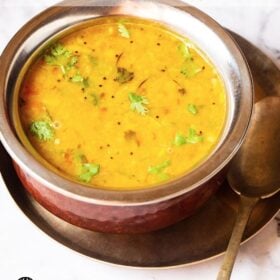
This is my favorite dal recipe. First time I followed exactly and loved it!
I have come to like using additional amounts of ginger, double tomato, a bold amount of hing, Kashmiri red chili powder, extra fenugreek leaves, and have learned that the lemon juice is really important.
I am going to find your explanation of the dhungar smoking method and try that. This is such a treat – having this kind of authentic Indian dal at home.
I grow a curry leaf plant at home as I find that it is key.
Thank you for sharing your expertise…
Great and thanks a lot. Thanks also for sharing your variations. The dhungar method imparts a lovely smoky flavor to the dal. But to some extent the same smoky flavor can be got by using smoked paprika, instead of kashmiri red chilli powder or cayenne pepper.
I tried many Dal recipes and this is by far the best Dal fry recipe I must say.
Thank you
Thanks a lot and glad! Most welcome.
Love your recipe…
Made it several times and always enjoyed by family and guests
Thank you so much
Great and thanks for sharing. Glad to know.
i never seen detailed instruction in any other cooking website. showing us 3 ways of cooking helps a lot. sometimes no pressure cooker changed whole dinner menu. very helpful! thank u!
Thanks a lot and welcome.
Loved the recipe! The dal turned out so tasty. Yum! Thank you so much 😀
Wonderful and thanks a lot for taking the time to comment and rate the recipe.
Love the taste!
Absolutely authentic recipe! It was so so tasty! THANK YOU!
Thank for the feedback and rating. Glad!
Awesome recipe. I tried it and my family loved it. Very tasty.
thanks a lot swati. glad to know and thanks for sharing this.
I tried making it.It became super delicious.Thank you!
Welcome Nivedita
Another awesome recipe.Turned out absolutely delicious.Loved it.
thanks winnie.
Absolutely delicious! Will certainly make this again, and add to my favourites 🙂
Totally enjoyed this recipe.
thanks for the feedback.
Very good recipe. I followed the recipe& it turned out great. Will be making it again as my family loved it. I served this dhal with tandoori roti.
thank you mina for this positive review on dal fry. glad to know. yes, dal fry tastes good with tandoori roti and even a phulka or paratha.
Hi, I am a frequent visitor of your site. You have some of the best veg recipes.
thanks ann.
If i want to serve 12 people.. do i triple the recipe ?
you can triple the recipe, but when adding hing, spice powders, kasuri methi please use the method of approximation or andaaz.
Cooked dal fry yesterday and it was yummy 🙂
Thanks Dhivya
Wow, I prepared dal fry yesterday and it was perfect… Thanks a ton Dassana…
Welcome Soumya
its amazing yar….
Hi .. is it okay to use the dhungar method here? Please reply asap
you can use.
Amazing recipe. Tastes like authentic dhaba style dal. Thanks for putting up these recipes Dassana. Your site is my number one go-to resource for the most consistently delicious recipes.
Welcome Minoo. Glad to know this. Thanks for sharing positive feedback on dal fry recipe.
All your receipes deserve 5 star rating. If everyone starts following your receipes then hotels will have a tough time..
Thanks Priti for your 5 star rating and positive words.
I made your dhal it was lovely please I would like a chicken biriyani recipe thanks Lenny
Welcome Lenny. We only share vegetarian recipes on the blog. So won’t be able to share the recipe requested.
Excellent recipe. To add a bit of crunchiness I put cut up spinach leaves it was delicious! Thank you for sharing.
Welcome Olivia. Thanks for sharing the variation you did.
Hi Dassana,
I tried this recipe for our office potluck lunch and it was a great hit among my friends. Thank you for all the effort you take in giving detailed recipes….especially the pictures. Due to this, the recipes that I try turn out almost exactly as shown on the website.
Whenever I have some item in my fridge or I want to try something new, I look up recipes on your website.
I used alphonso mangoes to make mango ice cream two weeks back. Now off to make mango kesari 🙂
Hats off Dassana and keep up the good work !
welcome estee. thanks for your positive feedback on dal fry. glad to know that you like the website.
Hi again
As for the pressure cook – how can I translate the “whistles count” to time in minutes?
thanks
noam, pressure cook for 9 to 10 minutes on medium flame.
Hi
Thanks for this recipe. Do you use total 0.5 cup on lentils in this recipe?
thanks.
yes total 0.5 cups of lentils. half cup of lentils usually serves 4.
Hello Ma’am
Your recipes are too good and easy to follow… As a fresher in cooking your recipes have helped me a lot… Thank you so Much…
The dal fry came out really well . All my family members loved it a lot.
Welcome Silpa. Glad to know that everyone liked the dal fry recipe. Thanks for your positive feedback on recipes.
Thank you.
My father liked it a lot. You are super in representation and presentation.
Welcome Nanditha. Thanks for your positive feedback.
seriously lost the count of chapatis my husband had. You are the best no doubt. I am a great fan of you.
Thanks Sumitha for your kind words and this awesome feedback.
Coz she herself was busy feasting. Thanks for the wonderful work. Sumi turned out a master chef. Credits to you. You guessed it rt. Am her hubby 🙂
thank you sri. isn’t it great when your partner (be if wife or husband) cooks good food. it definitely helps ?
Excellent recipe. It came out nice, though I din add garam masala and methi leaves. Thank you so much.
thanks ashikai for the feedback. nice to know.
Hi, thank you for another awesome recipe. Just a heads up, the amount of garam masala needed is missing in the written list of ingredients but I found it in the captions under your pictures.Thanks for this phenomenal tutorial. Your website is the best at breaking down recipes step by step.
Welcome Cj. Glad to know that you liked the dal fry recipe. Thanks for your appreciation and also for mentioning about the garam masala. I have mentioned the garam masala in ingredient list also.
I made this for my husband last night who is from South India. He took it to the table and quickly ran back in to the kitchen with a shocked look, “This is too good!”. He loved it so much, as did I. He now wants me to cook it again. Thank you 🙂
Welcome Sarah. Glad to know that both of you liked the dal fry recipe.
Most delicious dal ever! Thank you!
Welcome Tammy
thank you, it was soooo good! I am saving your website so I can make more recipes!
Welcome Giusi. Glad to know this.
Your recipes are a blessing. Have tried so many of them and all have come out to be absolutely delicious dishes, earning me appreciation each time ?
Thank you so so much. God bless.
Welcome Veena. Thanks for your kind words and best wishes.
superb. Love you so much.
thank you deepa ?
I have about 5 vegetarian Indian cookbooks, and although I adore two of them, your food is always my favourite. I’ve cooked your recipes about 15 times now since I promised myself I’d get some basic skills in Indian cookery, and I’ve enjoyed them every time. Thank you for your effort with this site and I wish you had a book I could buy.
Welcome Lucy. Thanks a lot for this positive feedback on recipes. We don’t have a plan to make the book right now. But may be in future.
favorite family recipe. Perfect
thank you vanitha.
The dal becomes thick and gets set after kept in fridge. Why does that happen?
most of the gravies and dals become thick. they even become thick at room temperature. i do not know the scientific reason as to exactly what happens with the food molecules, but the cool temperature does thicken the dal.
Dal when it cools down becomes thick because the starches present in the dal stiffen up. Also the protein strands change with heating and cooling, making a thicker texture.
This is a very unscientific description of the food science, but if you google it you can see more detailed explanations.
I must say I love the recipes on your site and I visit often.
SS, thanks a lot for this info. i will search in google for a more detailed explanation. also thanks for the feedback on the recipe. happy cooking.
GREAT recipe!!!
thanks sam.
hi, i love your recipes. thanks a lot. you are my saviour. i have never cooked earlier but now i can cook and get appreciation
pleased to know this vanshika 🙂 thanks for positive views.
Hi Dasanna
Usually I am not fond of dal I wanted to prepare in a tasty way so I tried your dal fry recipe and I had it all alone ? So yummy
pleased to know you liked the dal fry recipe, thanks for positive views.
Finally found the recipe for dal fry which i love in restaurants ! Thank u soo much dassana. All ur recipes are highly recommended.
pleased to know this thank you swathi for your kind and encouraging words 🙂
It’s delicious awesome
thank u so much
welcome nazira and thank you.
Please, mam share some soyabean chunk recipes
sandeepta, i do not make soyabean chunks or granules recipe as i do not use them. i have read that they are made with low grade ingredients, which are not healthy. i am not getting the link where i read. otherwise i would have shared with you.
Love the flavor of this recipe. It’s so aromatic and delicious! Thank you for the recipe.
welcome akshatha and thankyou so much 🙂
Thank you
welcome.
Photos and Recipe are awesome.
thankyou lekhraj 🙂
Its been many years since I have been looking for this Dal Fry recipe. So long that I have forgotten when I last tasted it. Anyways, it came out awesome. I have high cholesterol so I went with about 1tbsp of ghee 🙂 And only one red and one green chilli. Many thanks for posting this.
pleased to know this prashant 🙂 thankyou for your kind words also you are welcome. do take care.
but what do you do if you don’t have a pressure cooker?
just soak the dal for an hour or two. then drain and keep aside. in a pot, add water and turmeric powder. when the water comes to a boil, add the dal and cook in an open pan. the scum which is formed when cooking, can be just removed with a spoon. simmer till the dal is cooked and soft. for about 1 cup of dal, you can use 3-4 cups water. tuvar dal takes longer time to cook than other dals. depending on the quality of the tuvar dal, it should take about 40 minutes to an hour to cook.
The recipe was really Good. Easy and tasty .I am regular follower of your recipes. Thanks dassana.
pleased to know this aruna thankyou so much 🙂
I tried the dal fry recipe from several websites… But nothing ever turned out to be as perfect as this one…
I always like to try new ways of cooking a particular dal or vegetable as cooking it same way all the time gets so boring… However.. sometimes the experiment goes wrong and I wish I had cooked it just like I always do..With your blog.. I can try the new way of cooking something without worrying about the outcome as nothing has ever gone wrong….
I cannot thank you enough for all the recipes…
Thank you 🙂
pleased to know this neha 🙂 thankyou for your positive words and god bless you.
Been stuck in this hotel room for a week now…was craving for some Indian food..tried your recipe and loved it..i had it with rice and also tried your other recipe for potato roast…was very satisfying..thank you..
pleased to know this balaji 🙂 thankyou for trying the potato roast and you are welcome.
I made this for my husband yesterday who usually likes non veg dishes more, but this just tasted awesome & he loved it. I made it with jeera rice.
Thank you so much for sharing the wonderful recup. .
thanks for the feedback soumya.
Thanks for this awesome recipe. So flavourful. Once made this for my folks and my mum has now switched from her usual dal recipe and made this her staple one now. Super tasty!
welcome maya. glad to know this.
Thank you so much for this recipe, I am the biggest dahl lover and have tried many recipes- this is the BEST!!! Thank you again for sharing
welcome justene
Wonderful recipe! For anyone using an electric pressure cooker, 2.5 cups of water to 1 cup of dal for 6 minutes (plus 10-minute release) seems to work well.
thanks jedidja for sharing this info.
Your recipes are very helpful and easy to understand .. Thanx a big fan 🙂
welcome shruti. thanks for your kind words.
One of the best dal fry recipe,subtle taste,perfect one.
thanks radhika
Hi Dassana,I tried this recipe yesterday and it was very very tasty, nice to eat with simple brown rice nd this dal.God bless you for your hardwork..do you have any nonveg recipes?
thanks laveena for your positive feedback and for your prayers. i only cook vegetarian recipes at home.
Just awesome! Even I can cook to surprise my wife and beautiful daughter. Thanks a lot!!!!!
welcome santosh
Hats off to you! You make life easier by posting such wonderful, easy, and delicious recipes. Thanks ma’am!
welcome riya. thanks for your kind words.
I searched on Google “How to prepare dal fry” and I found this link. Thanks Amit, for sharing this recipe. My friend liked the dal I prepared for the first time. This saved me today.
welcome nilesh. glad to know this.
Dassana all yr recipes r awesome, the step by step process is very helpful thank u……….
welcome sukanya. thanks for sharing positive feedback on recipes.
Just returned from india and so missing the delicious food. This recipe is really great. I will add tho to my repertoire of excellent dines to make at home. Thank you for sharing this.
welcome jane. good to know this.
Tasty
Delicious! I love this recipe! Thank you!
welcome jessica
I love Indian foods. The recipe you have shared! so good in taste, liked it so much thanks for sharing it.
welcome anina
It turn out to very good.i loved it .even my wife is asking recipe from me.
thanks ramesh for sharing positive feedback.
dassana amit . Lovely recipe.. i really like your all recipes… AWESOME… I WANT THE RECIPE OF SOYA BEAN TIKKA OR CHAAP..
thanks. noted down your request. will try to upload.
Love it. I’m not indian but my lovely wife is from Bombay and she has given it rave reviews. The one thing is, when I use my pressure cooker (brought from India), the dal liquid goes flying everywhere with each whistle. Is there a way to minimize this?
Thank you again and I hope you post some Sindhi recipes in the future so I can score even more points.
it depend on the size of the pressure cooker. also how much water is added to the dal. generally i add about 2.5 to 3 cups of water for 1 cup of dal. if you add oil about 1/4 to 1/2 tsp of oil to the dal, then the liquids don’t come out from the cooker.
Really fine.l loved it
Awesome… Was looking this. It turned out the way I wanted… Thank u very much. Could you tell how to bring that charcoal smoke flavor to dal tadka just like resturant…
thanks. to get the charcoal flavor, you will have to first burn the a small piece of charcoal till its red hot. then place it in a steel bowl. place this steel bowl with the charcoal in the dal. the dal has to be of a slight thick consistency, otherwise the steel bowl will immerse in it. sprinkle 1/2 tsp of ghee or oil on the red hot coal. then cover the dal and the bowl with a lid. let the smoke infuse for a few minutes. the longer you keep, the food gets a heavy smoking flavor, which is not advised. so just keep for 2 to 3 minutes and then remove the lid.
My friend make the recipe of fry dal and everyone like it. I will also try to make.
Thank you so much.
welcome muskaan
Hey mam,
thank you so much for this simple and delicious recipe. i tried as your post suggest. I can’t tell you how much i liked it. very tasty ……………
Thanx from bottom of my heart
keep doing this
welcome abhishek and big thanks for this sweet feedback.
Thank you!!! I just prepared dal it was just fantastic!! Please keep posting for new leaner’s like me…
welcome sagar.
Just tried ur dal fry….it’s out of the world. ..I’m such an awkward cook…This recipe made my hubby n children wonder if it’s ordered from the restaurant. …yeah…I’m so thrilled. ..Thank u so much…God bless you
welcome usha. good to know that the dal fry turned out very well. do try more recipes.
Tried the dal today and it turned out to be really good. Thanks for the recipe. Will be trying your bhindi recipe next . By the way do you have a dry Allo Mattar recipe also? Thanks.
welcome anil. dry aloo matar recipe link is below:
https://www.vegrecipesofindia.com/dry-aloo-matar-recipe/
Many thanks Dassana.
welcome anil
SUPER .. SUPER..
This is the best dhal fry recipe I’ve found! Thanks for sharing 🙂
welcome chloe
Thank you for the detailed guide. Prepared the dish and it turned out exactly as shown.
welcome harisankar
Thank you very much 🙂 Tried and turned out as winner.Easy to cook and great to taste !!!
welcome rohit
Just tried this recipe tonight. My family loved it. Definitely saving this one! Thanks 🙂
welcome amanda
Tried the dal recipe today and it turned out really awesome 🙂 .
thanks mahima
nice:)
Hi!
Tried this recipe 3 times! Just awesome! Tastes better than dhaba dal! Great work! Thank you!!!
welcome anil and thanks for this positive feedback on dal fry recipe.
hey, this is the first time im making something which is this dal fry… but after making it, i noticed in the picture u used a different pan than mine so… does it make any difference, like in the taste or something?
Loved the recipe though….
thanks muskan. are you talking about the kadai. yes, there is a slight difference in the taste depending upon the kind of pan and which material the pan is made of.
Thank you. Very detailed recipe I have tried and turned good.
welcome noora
It’s very fantastic.
your recipes are really tastier. great
Thank you.love you…love you.meri life ki first dish jo mene bnayi aapki recepie dekhkar.. and I got so many compliments.
welcome aditi. you made my day.
It was very nice,and was not difficult
Hey Dassana!
I tried your recipe, and it is superb. Highly recommend everyone to try this. I got nothing but compliments for this dish. And thank you for the no-pressure-cooker tips. Thank you!
Regards,
Sheila
welcome sheila
oswem.very nice.very testy.
I tried cooking first time and it was awesome experience with this recipe. thanks a lot.
welcome amit
for preparation ghee is use this is of which brand .because the restaurant the smell is different. so kindly say the brand of restaurants using ghee.
the aroma in restaurants is the charcoal flavor. you can use any brand of ghee.
No pressure cooker, but we soaked overnight and cooked till tender in a open pot.
Mashing and such just does not get the same look as in your pictures. We put it in a blender for a little bit but not to long. (when cool, not when hot)
It still is a bit chunky, ideas on what we can do to get it right?
Four stars because of us not you… 🙂
to get the mashable consistency, the lentils have to be cooked more. the recipe is not chunky at all. actually it also depends on the pigeon pea lentils one gets abroad. what i have heard, is that some of them are really tough to cook and take a lot of time. i would suggest to buy a good quality from a reliable brand. organic brands are much better.
if you still have the blended lentils, gather all of it in a pan. add hot water and simmer on a low to medium flame with frequent stirs in a pot. cooking the soaked lentils in a pot should take approx 45 mins to 1 hour or more depending on the quality of the lentils. i would also suggest to make the same dal fry recipe with mung lentils as they are faster to cook as compared with pigeon pea lentils.
Hi! Excellent recipe, been combing the net for one I really liked and wanted!
Question, do you know how to cook the dal without a pressure cooker? I’ve developed a lifelong phobia of that device, and I can’t use it. Thank you!
just soak the dal for an hour or two. then drain and keep aside. in a pot, add water and turmeric powder. when the water comes to a boil, add the dal and cook in an open pan. the scum which is formed when cooking, can be just removed with a spoon. simmer till the dal is cooked and soft. for about 1 cup of dal, you can use 3-4 cups water. tuvar dal is the toughest to cook in a pot. the other dals cook pretty fast. depending on the quality of the tuvar dal, it should take about 40 minutes to an hour to cook.
Hello Dassana,
I am so happy that I found your site. In 1981 I was in Jaipur for a couple of weeks. I lived in a sleeping hall with some ten other men in a cheap lodge near the railway station. Every morning, I had dal fry and chapatis at a very simple street-side restaurant nearby. That dal fry has haunted me ever since, and I have tried to cook it many times without success. I have even tried to find it at restaurants in south India at later visits to your country – to no avail. But now, thanks to your fantastic recipe, I have today had a meal that comes very close to how I remember the dal fry in Jaipur.
Thank you so much for this recipe. I will browse your other ones as well.
Best wishes from Stockholm, Sweden,
Magnus
Hello Magnus
Thanks for this sweet comment.
I am glad, finally you found the dal fry recipe you were looking for.
You are can try other indian recipes as well.
Thanks
Dassana
Hello again, Dassana,
Yesterday I made your aloo palak. I couldn’t get any fresh spinach, so I used some fresh mangold instead. What a lovely recipe. Today, I am making dal fry again, plus aloo matar.
Your blog is a gold-mine of vegetarian recipes for me!
Best,
Magnus
thanks magnus for these awesome words.
Daal fry its a very easy and nice recipe
Easy to coook and its take very less tym
thanks papia
another wonderful recipe dassana! tried it today & it was a big hit in my house! i consider dal as comfort food & ur recipes just do that…give me pleasure in eating! just a request….can u post Bread Upma recipe for me please….
thanks jyoti. i will post bread upma recipe in some time.
Your all recipes are awesome…
Fabulous taste…. Best recipes
Thnx…..
Dassana Amit
welcome riya. thanks for your kind words.